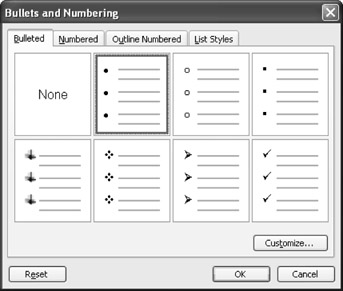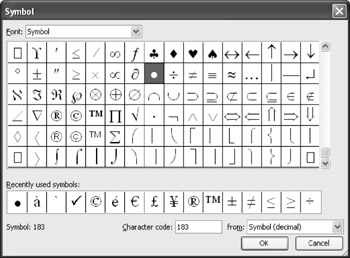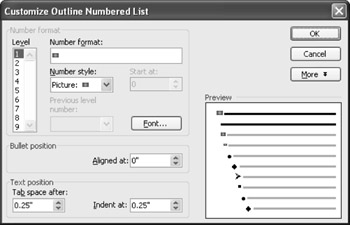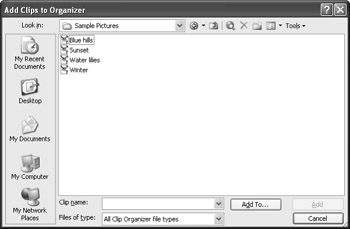Enhancing Bulleted Lists
|
| < Day Day Up > |
|
The default Word settings for bulleted and numbered lists are fine when you're creating a quick, simple document that will be passed around the office and eventually end up in the dumpster. But what about those special reports you create or the procedure manuals that others rely on? Those need to have a more professional look and feel, and the treatment of the lists in your document suddenly become more important.
You can improve a basic bulleted list in several ways. You might want to customize your list by choosing your bullet style from the bullet library, selecting a picture bullet, creating your own bullets, or changing indents and spacing for your bullet items.
Choosing a New Bullet from the Bullet Gallery
Word gives you a gallery of seven preset bullet styles to choose from and a virtually unlimited supply of bullet options you can pull from symbol typefaces, graphics libraries, and more. To choose a new bullet character for a list, follow these steps:
-
Select the list items with the bullets you want to change, or position your cursor where you want to add a list.
-
Choose Format, Bullets And Numbering. The Bullets And Numbering dialog box appears, as shown in Figure 8-15.

Figure 8-15: Changing the default bullet to another Word bullet style is a simple matter of point-and-click. -
Select the new bullet you want to use by clicking the preview box of your choice.
-
Click OK to return to your document. The bullet character is added and your list is updated with the new style.
Tip Right-click to format bullets or numbering A quick way to access the Bullets And Numbering dialog box is to select your list, right-click, and then choose Bullets And Numbering from the shortcut menu.
Selecting a Bullet Character Outside the Default Preset Gallery
If the preset gallery bullets don't work for you, you can select one of the preset options that you won't need, and click Customize in the Bullets And Numbering dialog box to start the process of changing your bullet character choices. When you click Customize, the Customize Bulleted List dialog box appears. In this dialog box, bullet character choices appear across the top of the dialog box, and below the bullet characters, three buttons enable you to access three types of bullet modifications: Font, Character, and Picture. Figure 8-16 shows the Customize Bulleted List dialog box.

Figure 8-16: The Customize Bulleted List dialog box gives you the means to change the font and character you use for bullets. You can also change bullet spacing and text position here.
Resetting a Default Preset Bullet Gallery
Keep in mind that when you specify a custom bullet, the new bullet will appear in the Bulleted tab in the Bullets And Numbering dialog box in place of the bullet you selected before you clicked Customize. If you'd like to revert to the default bullet, you can do so, as follows:
-
Choose Format, Bullets And Numbering, and click the Bulleted tab if necessary.
-
Select the preview box that you'd like to return to the default setting.
-
Click Reset. A message box appears, asking if you'd like to reset the gallery position to the default setting.
-
Click Yes, and the default bullet for the selected gallery position appears in the Bulleted tab.
To reset the entire bullet gallery to the default settings, you'll have to select and reset each gallery position in the Bulleted tab in the Bullets And Numbering dialog box.
Changing the Bullet Font
When you click Font in the Customize Bulleted List dialog box, the Font dialog box appears, as shown in Figure 8-17. Here you can select a typeface and change font settings for bullet characters.

Figure 8-17: The Font dialog box enables you to change a bullet character's typeface, style, color, and text effects.
From within Word, you can access a few typefaces that include symbols that can be used as bullet characters. Some typefaces you might find useful for custom bullets include MS Outlook, Symbol, Webdings, and Wingdings. Of course, you can use any character, alphabetic or otherwise, as a bullet character. But unless you're creating an outline, letters as bullets can be less clear for readers than graphical symbols.
Changing a Bullet Character
When you customize bullets, you can click Character in the Customized Bulleted List dialog box to display the Symbol dialog box, as shown in Figure 8-18. The Symbol dialog box displays available characters for selected fonts. You can change font selections in the Symbol dialog box by choosing a font in the Font list box. After you find a character you want to use, simply click the character, and then click OK.

Figure 8-18: Click the symbol you want to select as a new bullet character. Make note of the character code of the item you select if you need to be consistent with lists in other documents.
| Cross-Reference | For more information about working with the Symbol dialog box, see Chapter 2, "Mastering Document Fundamentals." |
Notice that you can see the numeric character code in either decimal or hexadecimal format for each character you select in the Symbol dialog box. This enables you to be sure you've used the same bullet throughout this document and in other documents that need a consistent style.
| Tip | You can resize the Symbol dialog box to view additional rows and columns of symbols at a time. |
Troubleshooting: My default bullet characters show up as clock faces
If your default bullets appear as clock faces, the most likely cause is that the Symbol font on your system is damaged. By default, Microsoft Word uses the bullet character from the Symbol font. If the Symbol font (Symbole.fon) is damaged or unavailable, Word replaces the bullet with a character from the Wingdings font. In the Wingdings font, the corresponding ASCII character is a clock face. To resolve this issue, delete the Symbole.fon file in the \%Windir%\Font folder, and then reinstall the Symbol font from your Microsoft Windows CD or from another computer that's running the same version of Microsoft Windows. Alternatively, if you don't want to reinstall the Symbols font, you can simply select another character from the Wingdings font in the Symbol dialog box, as described in this chapter.
Using a Picture Bullet
We live in an age of pictures—television and the Web have raised the bar on what we expect in terms of aesthetic presentation of information. One way you can subtly add imagery to your documents is to use picture bullets. Used judiciously, picture bullets in your documents can effectively liven up a document by adding color and interest to text.
What is a picture bullet? Simply, it's a graphic image that's small enough to use as a bullet character. Word offers a range of bullet styles and shapes, included animated bullets that you can use online. To display the Picture Bullet dialog box and see the available offerings, ensure that a bullet gallery position is selected in the Bullets tab in the Bullets And Numbering dialog box, click Customize, and then click Picture in the Customize Bulleted List dialog box. The Picture Bullet dialog box appears, as shown in Figure 8-19.

Figure 8-19: Picture bullet options appear in a dialog box that includes a Search Text option.
To select a picture bullet, you simply click the one you want, and click OK. Word adds the picture bullet to the Bullet Character choices section in the Customize Bulleted List dialog box. Ensure that the newly added bullet is selected in the Bullet Character section, and then click OK. You'll then be able to select the picture bullet as the bullet of choice in the Bullets And Numbering dialog box.
If you don't see a picture bullet that you want to use in the Picture Bullet dialog box, enter text in the Search Text box, and click Go. Word will search clip art and online files. Online bullet options appear with an image of the world in the lower-left corner of the preview picture. Further, animated bullets (bullets that will appear with small movements, size changes, or color changes when the bullet is viewed online in a Web page) appear with a star in the lower-right corner of a preview picture, as you can see in the first button preview shown in Figure 8-19.
Creating a Multilevel List with Picture Bullets
At times, you might want to create complex bulleted lists that consist of multiple sublevels. In many cases, you'll probably display a complex list as a numbered or lettered outline, but in some instances, you might want to create a list with picture bullets using a different picture for each level. If you're using a built-in theme in your document, many Office themes already supply pictures or symbols for each level in a multilevel bulleted list. But if you'd like to create a custom bulleted list, you can do so by following these steps:
-
Select the list items with the bullets you want to change, or position your cursor where you want to add a list.
-
Choose Format, Bullets And Numbering, and then click the Outline Numbered tab. The Outline Numbered tab (shown in Figure 8-20) enables you to format the styles of bullets or numbers that will appear for each level in a complex list.

Figure 8-20: The default Outline Numbered gallery includes a preset option for multilevel lists that uses character bullets. -
Select a gallery option that you'd like to replace with your custom settings (for simplicity's sake, you might want to choose a list style from the top row), and click Customize. The Customize Outline Numbered List dialog box appears, as shown in Figure 8-21.

Figure 8-21: To create complex lists with custom bullets, you specify a bullet style for each list level by configuring the Customize Outline Numbered List dialog box. -
In the Level box, click 1, or click the top row in the Preview window.
-
In the Number Style box, select New Picture. The Picture Bullet dialog box appears, as shown earlier in Figure 8-19.
-
Select a picture bullet, click OK, and then repeat steps 4 and 5 to format the sublevels in your list (remember to select a level number or click the level in the Preview window).
-
When you finish adding pictures to all the levels in your list, click OK.
After you configure a multilevel picture bullet list, you can insert the custom bullets while you type. To insert a sublevel item with its accompanying bullet, press Enter, and press Tab for each level. You can also format a list by using the Increase Indent and Decrease Indent buttons on the Formatting toolbar to format new and existing bulleted text.
| Tip | To reset an Outline Numbered list to the default setting, click the gallery position in the Outline Numbered tab in the Bullets And Numbering dialog box, and then click Reset. |
| Cross-Reference | For more information about creating outlines and numbered outline lists, see Chapter 10, "Outlining Documents for Clarity and Structure." |
Importing Custom Bullets
If you create other bullets you want to use in your Word documents, you can add them in the Picture Bullet dialog box. To do so, follow these steps:
-
Choose Format, Bullets And Numbering, and click the Bulleted tab.
-
Select a gallery position in the Bulleted tab, and click Customize.
-
Click a Bullet Character position that contains a picture you'd like to replace, and click Picture.
-
In the Picture Bullet dialog box, click Import. The Add Clips To Organizer dialog box appears, as shown in Figure 8-22.

Figure 8-22: Add your own picture bullets by clicking the Import button in the Picture Bullet dialog box, browse to and select the file you want, and then click Add To. Word provides some sample pictures you can use to test this feature.Note To use your images as Word picture bullets, save the files in Graphics Interchange Format (GIF), bitmap (BMP), or Joint Photographic Experts Group (JPEG) format.
-
Browse to the folder containing the picture you want to add, click the picture, click Add To, and then click OK. The picture appears in the Bullet Character section in the Customize Bulleted List dialog box.
-
Ensure that the newly added picture is selected, and click OK.
Word adds the picture to the Bulleted tab in the Bullets And Numbering dialog box, thereby making it easily accessible in the future.
Changing the Bullet Indent
When you first create a bullet the Word-default way, the program indents the bullet by ¼ of an inch, or 0.25 on your ruler. Text begins at the 0.5 marker. Although this is the default setting, you might want to change the indent level to either move the bullet farther out toward the text margin, or inward, to put more space between the edge of the page and the bullet character and text. To make your changes, select a bullet style in the bullet gallery in the Bulleted tab in the Bullets And Numbering dialog box, click Customize, and then make changes in the Customize Bulleted List dialog box in either of the following ways:
-
Increase indent To increase the space between the left edge of the page and the bullet character, click the Indent At up arrow in the Bullet Position section of the Customize Bulleted List dialog box, or enter a value in the box.
-
Decrease indent To decrease the indent, click the down arrow, or click in the Indent At box and type the value you want.
Tip Use the ruler to adjust list formatting You can also reformat a list by using the ruler (to display the ruler, choose View, Ruler). To format a list using the ruler, simply select your list, and then change alignment and indent settings by moving the indent and tab markers on the ruler.
Modifying Text Position in Lists
Depending on the bullet character you choose, you might want to add more space between the character and the beginning of the text. By default, Word separates the bullet and the text beginning by ¼ of an inch, or 0.25 on your ruler. The text itself begins at the 0.5 marker.
You can change both these settings by changing the Text Position settings in the Customize Bulleted List dialog box. Here's how:
-
Make sure the bullet items are selected in your document or that your cursor is positioned in an empty paragraph where you want to start a bulleted list.
-
Choose Format, Bullets And Numbering.
-
In the Bullets And Numbering dialog box, select the bullet style you want to customize, and click Customize. The Customize Bulleted List dialog box appears.
-
In the Text Position section of the dialog box, click the up or down arrow in the Tab Space After box to change the amount of space between the bullet character and the beginning of the text.
-
In the Indent At box, click the up or down arrow to increase or decrease the position at which you want the text to begin. In both this step and the previous one, you can click in the box and type the value if you prefer.
-
Click OK to accept the new bullet settings and return to your document.
Note As always, if you don't like the changes, you can press Ctrl+Z to undo your last operation or you can reset the gallery position. Also, remember that you can modify list alignment settings by dragging indent and tab markers on the ruler.
|
| < Day Day Up > |
|
EAN: 2147483647
Pages: 373